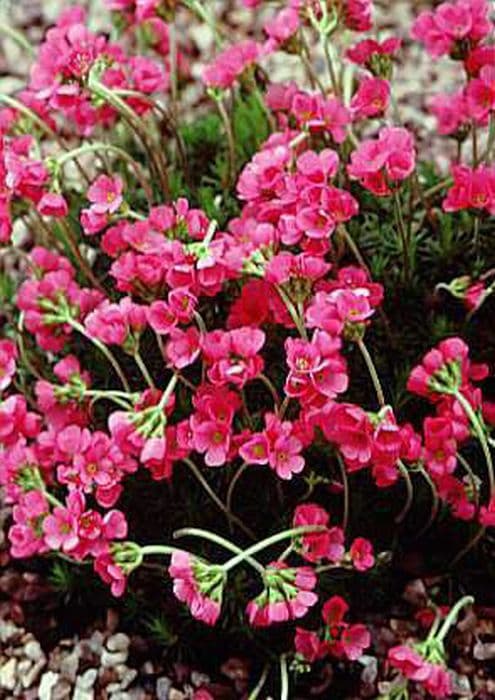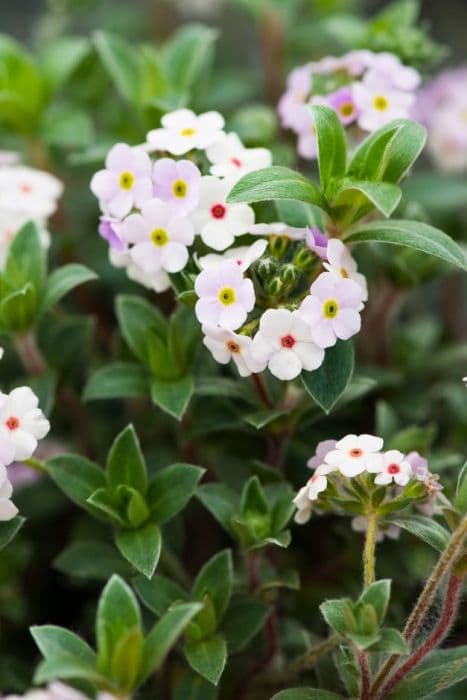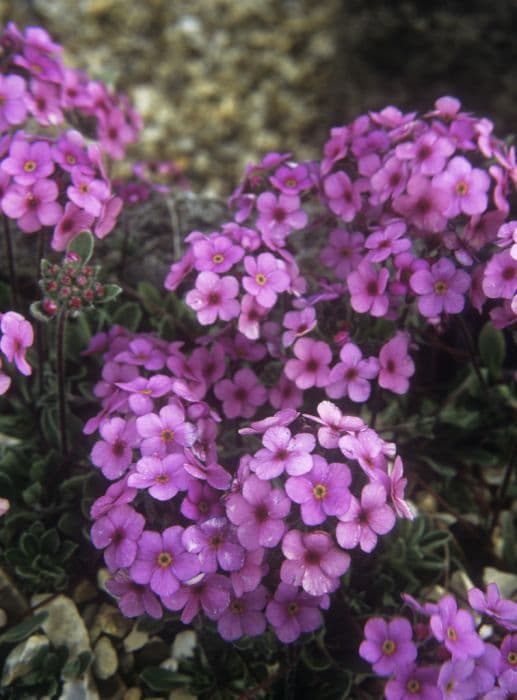Candelabra Primrose Primula pulverulenta (Pf)

ABOUT
Primula pulverulenta, commonly known as the candelabra primrose, is a perennial plant recognized for its striking floral display. This species typically showcases a rosette of long, tongue-shaped green leaves, which can be quite lush in their arrangement. The leaves are somewhat crinkled with a rough texture, providing a verdant backdrop for the plant's most prominent feature: its tiered towers of flowers. The flowers of the candelabra primrose bloom in whorls, encircling upright, slender stems which could be visually compared to the shape of a candelabra. Each whorl comprises several small individual blooms that form an attractive ring around the stem. The flowers possess a vivid hue, often in striking shades of pink, red, or magenta, with a small yellow center that creates a delightful contrast against the darker petals. The overall appearance of the candelabra primrose is one of bright, eye-catching tiers of flowers rising above a bed of lush green foliage. Its bold coloration and unique tiered arrangement of blossoms make it a standout plant in any garden setting where it brings a touch of elegance and a vertical accent to the floral display.
About this plant
 Names
NamesFamily
Primulaceae.
Synonyms
Candelabra Primrose, Powdered Primrose, Himalayan Meadow Primrose.
Common names
Primula pulverulenta.
 Toxicity
ToxicityTo humans
Primula pulverulenta, commonly known as candelabra primula, is not considered toxic to humans. However, some individuals may experience skin irritation or allergic reactions when coming into contact with the plant due to the presence of primin, a compound in the plant's sap. Ingesting any part of the plant is not recommended, but it does not typically lead to serious poisoning. If ingested in large amounts, one might experience mild stomach upset, but significant toxic effects are rare.
To pets
Candelabra primula is not known to be toxic to cats, dogs, or other pets. While not typically associated with severe toxicity, ingestion can sometimes lead to mild gastrointestinal upset, such as vomiting or diarrhea, particularly if a pet eats a large quantity of the plant. It is always a good practice to discourage pets from eating plants since individual animals may have variable sensitivities, and some might react adversely to substances that are not generally considered toxic.
 Characteristics
CharacteristicsLife cycle
Perennials
Foliage type
Deciduous
Color of leaves
Green
Flower color
Magenta
Height
2 feet (60 cm)
Spread
1 foot (30 cm)
Plant type
Herb
Hardiness zones
5
Native area
China
Benefits
 General Benefits
General Benefits- Aesthetic Appeal: Primula pulverulenta, commonly known as candelabra primrose, features striking tiered whorls of vibrant pink-purple flowers that bloom in late spring to early summer, adding visual interest to garden landscapes.
- Pollinator Attraction: The flowers of candelabra primrose attract a variety of pollinators, including bees and butterflies, which are essential for the pollination of many plants and the health of ecosystems.
- Habitat Enrichment: Candelabra primrose can be used to enhance biodiversity in gardens and natural spaces by providing habitat and food sources for wildlife.
- Shade Tolerance: Candelabra primrose thrives in partial shade, making it a suitable choice for underplanting in woodland gardens or shaded borders.
- Moisture-Loving: This plant is well-adapted to moist and boggy conditions, and can be utilized in challenging wet garden areas where other plants might not thrive.
- Seasonal Interest: Offers distinct seasonal variation with lush green foliage in spring and summer, and then dying back to ground level in autumn and winter, allowing for seasonal garden planning.
- Ease of Cultivation: Primula pulverulenta is known for being relatively easy to grow and maintain, which is attractive to both novice and experienced gardeners.
 Medical Properties
Medical Properties- This plant is not used for medical purposes.
 Air-purifying Qualities
Air-purifying QualitiesThis plant is not specifically known for air purifying qualities.
 Other Uses
Other Uses- Primula pulverulenta, also known as candelabra primrose, can be used in small-scale water filtration systems, with its dense roots helping to remove particulates from water.
- The plant's nectar is rich and can be used as a lure in traps for certain insects for scientific studies or pest control, being especially attractive to bees.
- Candelabra primrose's robust and colorful blooms can be used as a natural dye source for fabrics or paper, producing a variety of subtle tints.
- The sturdy stems and leaves can be incorporated into art projects, such as pressed flower crafts or botanical prints.
- During educational nature activities, candelabra primrose can serve as a good example of a plant that thrives in moisture-rich environments, aiding in teaching about plant habitats.
- The plant can be used in photography as a live model to teach macro photography techniques due to its intricate flower structures.
- In culinary arts, the petals can be used to add a splash of color to salads or as an edible decoration on desserts, though they are not commonly known for their flavor.
- Gardeners can use candelabra primrose as a tool for teaching young gardeners about pollination, as it is frequented by a wide variety of pollinators.
- Its long blooming season and tiered flower structure can be beneficial for studying the life cycle and growth patterns of perennial plants in horticulture education.
- The flowers of the plant can be used in potpourri mixtures, providing a subtle fragrance and adding visual appeal with their unique shape and color.
Interesting Facts
 Feng Shui
Feng ShuiThe plant Primula is not used in Feng Shui practice.
 Zodiac Sign Compitability
Zodiac Sign CompitabilityThe plant Primula is not used in astrology practice.
 Plant Symbolism
Plant Symbolism- Youthfulness: Primula pulverulenta, commonly known as the candelabra primrose, often symbolizes youth and vitality due to its fresh and vibrant appearance.
- New Beginnings: The candelabra primrose blooms in the spring, which is often associated with new beginnings and the start of new ventures or phases in life.
- Hope: As a spring flower, the candelabra primrose represents hope and the belief in a better future after a long winter.
- Patience: The plant's growth cycle requires patience, as it takes time to develop its characteristic tiered blooms, representing the virtue of waiting for rewards.
- Diversity: With its variety of colors, the candelabra primrose is thought to symbolize diversity and the inclusion of many different perspectives.
 Water
WaterThe Candelabra Primrose should be watered regularly to keep the soil evenly moist but not soggy, preferring about 1 gallon of water per week during the growing season. Reduce watering in winter but never let the soil dry out completely. It's best to water this plant in the morning to allow any moisture on the foliage to dry out over the day to prevent disease. During hot spells or dry seasons, you may need to increase watering frequency to maintain consistent soil moisture.
 Light
LightThe Candelabra Primrose thrives in partial shade, ideally receiving morning light and shelter from the harsh afternoon sun. An east-facing garden spot or the dappled shade under a canopy of trees would provide the perfect lighting conditions for this plant.
 Temperature
TemperatureThe Candelabra Primrose prefers cool temperatures and can survive a range of 40 to 75 degrees Fahrenheit. The ideal temperatures for robust growth are between 50 and 70 Fahrenheit. They can tolerate light frosts, but extended periods of heat can cause stress to the plant.
 Pruning
PruningThe Candelabra Primrose should be pruned to remove dead or faded flowers, which encourages new blooms and prevents the plant from spending energy on seed production. Pruning can be done after the primary bloom period in late spring or early summer. Cut back the spent flower stalks to the base of the plant.
 Cleaning
CleaningAs needed
 Soil
SoilThe best soil mix for Candelabra Primrose should be rich, moist, and well-draining with added organic matter such as compost or leaf mold. A soil pH ranging from 6.0 to 7.0 is ideal for optimal growth and flower production.
 Repotting
RepottingCandelabra Primrose should generally be repotted every one to two years to replenish nutrients and prevent the plant from becoming root-bound, promoting healthy growth and blooming.
 Humidity & Misting
Humidity & MistingCandelabra Primrose thrives in moderate to high humidity levels, preferring conditions that are similar to its native damp woodland habitats, while avoiding excessively dry air.
 Suitable locations
Suitable locationsIndoor
Keep in bright, indirect light; ensure moist, well-draining soil.
Outdoor
Choose partial shade, keep soil moist and enriched.
Hardiness zone
5-8 USDA
 Life cycle
Life cyclePrimula pulverulenta, commonly known as candelabra primrose, begins its lifecycle as a seed that germinates in moist, well-drained soil, typically needing a period of cold stratification to break dormancy. Upon germination, the seedling emerges and develops into a rosette of basal leaves, which is the vegetative stage of the plant. As it matures, candelabra primrose produces a tall stem with whorls of bright pink to magenta flowers, each tier blooming in sequence from the bottom up, in its flowering stage which usually occurs in late spring to early summer. After pollination by insects, the flowers produce seed capsules that eventually dry and release seeds, completing its reproductive cycle. The plant is a perennial, so after the flowering phase, unless it experiences severe weather conditions or disease, it will enter a period of dormancy in the winter before resuming growth in the spring. During its life, the candelabra primrose may also spread asexually by division of the root clump, thereby expanding its presence in the habitat.
 Propogation
PropogationPropogation time
Spring-early summer
Primula pulverulenta, commonly known as the candelabra primrose, is propagated most effectively by seed. The optimal time for sowing these seeds is late winter to early spring, capitalizing on the cool temperatures that support their germination. To propagate by seeds, one should scatter the seeds thinly on the surface of a moist, well-drained seed compost in a tray and then lightly cover with a fine layer of compost or vermiculite. The tray should be placed in a cold frame or unheated greenhouse and kept at a temperature of around 41 degrees Fahrenheit (5 degrees Celsius). The seeds typically take 14 to 30 days to germinate. It is crucial to not let the seedlings dry out, and once they're large enough to handle, they can be transplanted into individual pots. After a period of growth, they can be moved to their final location in the garden.









